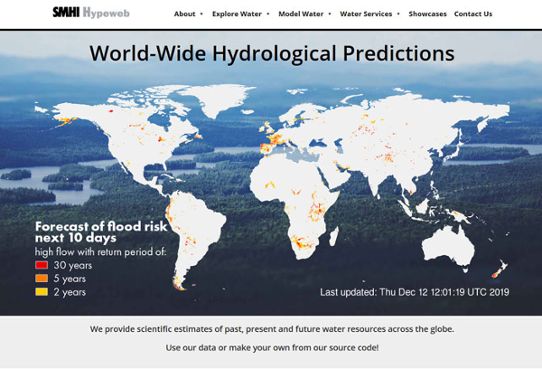
The Hydrological Predictions for the Environment (HYPE) model is a semi-distributed catchment model, which simulates water flow and substances on their way from precipitation through different storage compartments and fluxes to the sea (Lindström et al., 2010). The model code is open source and describes hydrological processes in different subbasins, although the algorithms are not purely based on physical laws but of more conceptual nature. It is meant to be applied in a multi-basin manner to achieve high spatial distribution of flow paths in the landscape. It can be evaluated against point measurements in the river network and against spatially distributed observations, such as Earth Observations or interpolated products from in-situ monitoring. The model was initiated in 2003, applied for entire Sweden in 2008 and then for different continents (Pechlivanidis et and Arheimer, 2015; Donnelly et al., 2016; Hundecha et al., 2016; Andersson et al., 2017) and finally for the entire globe (Arheimer et al., 2019).
Among the model applications, the HYPE application for Sweden, S-HYPE (Strömqvist et al. 2012), is the one most frequently used operationally. For instance, it is used for operational forecasting of floods and droughts (e.g. Pechlivanidis et al., 2014), and assessments of water quality (e.g. Arheimer et al., 2015), as well as impacts from hydro-morphological alterations (e.g. Arheimer and Lindström, 2014) and climate change (e.g. Arheimer et al., 2017; Arheimer and Lindström, 2015) in Sweden. The model system is based on the HYPE model (Lindström et al., 2010) which is a catchment-based, process-oriented model, describing river flow generation from rainfall distribution and temperature. The model calculates evapotranspiration, snow storage and melt, soil moisture, groundwater fluctuations, routing in lakes and streams along the river network from source to sea.
The S-HYPE model is continuously developed and improved. The model has a large number of parameters, and is largely calibrated manually, making maximum use of hydrological judgement and experience. The S-HYPE model uses a daily time step. It is calibrated regionally, i.e. not tuned for individual stations but calibrated stepwise for specific hydrological processes using representative gauges from the full dataset to be robust enough for predictions also in ungauged basins (Arheimer and Lindström, 2013). In addition to this, there are deviations in a handful of key parameters (such as precipitation and temperature corrections) for parameter regions (Lindström, 2016).
To learn more about the HYPE model and its applications, please go to: hypeweb.smhi.se/.
References
Andersson, J.C.M., Arheimer B., Traoré, F., Gustafsson, D., Ali, A. (2017). Process refinements improve a hydrological model concept applied to the Niger River basin. Hydrological Processes 31(25), pp.4540-4554. https://doi.org/10.1002/hyp.11376
Arheimer, B., Pimentel, R., Isberg, K., Crochemore, L., Andersson, J. C. M., Hasan, A., and Pineda, L. (accepted). Global catchment modelling using World-Wide HYPE (WWH), open data and stepwise parameter estimation, Hydrol. Earth Syst. Sci, https://doi.org/10.5194/hess-2019-111, in press, 2019.
Arheimer, B., Donnelly, C. & Lindström, G. (2017). Regulation of snow-fed rivers affects flow regimes more than climate change. Nature Communications 8(62). doi:10.1038/s41467-017-00092-8. https://www.nature.com/articles/s41467-017-00092-8
Arheimer, B., Nilsson, J. & Lindström, G. (2015). Experimenting with Coupled Hydro-Ecological Models to Explore Measure Plans and Water Quality Goals in a Semi-Enclosed Swedish Bay. Water 7(7):3906-3924. doi:10.3390/w7073906
Arheimer, B. & Lindström, L. (2013). Implementing the EU Water Framework Directive in Sweden. Chapter 11.20 in: Blöschl, G., Sivapalan, M., Wagener, T., Viglione, A. & Savenije, H. (Eds). Runoff Predictions in Ungauged Basins – Synthesis across Processes, Places and Scales. Cambridge University Press, Cambridge, UK. (p. 465) pp. 353-359.
Arheimer, B. & Lindström, G. (2014). Electricity vs Ecosystems – understanding and predicting hydropower impact on Swedish river flow. In: Evolving Water Resources Systems: Understanding, Predicting and Managing Water–Society Interactions Proceedings of ICWRS2014, Bologna, Italy, June 2014. IAHS Publ. 364: 313-319.
Arheimer, B. & Lindström, G. (2015). Climate impact on floods: changes in high flows in Sweden in the past and the future (1911–2100), Hydrol. Earth Syst. Sci., 19:771-784, doi:10.5194/hess-19-771-2015.
Donnelly, C, Andersson, J.C.M. and Arheimer, B. (2016). Using flow signatures and catchment similarities to evaluate a multi-basin model (E-HYPE) across Europe. Hydr. Sciences Journal 61(2):255-273, doi: 10.1080/02626667.2015.1027710
Hundecha, Y., Arheimer, B., Donnelly, C., Pechlivanidis, I. (2016). A regional parameter estimation scheme for a pan-European multi-basin model. Journal of Hydrology: Regional Studies, Volume 6, June 2016, Pages 90-111. doi:10.1016/j.ejrh.2016.04.002
Lindström, G., Pers, C., Rosberg, J., Strömqvist, J. & Arheimer, B. (2010). Development and testing of the HYPE (Hydrological Predictions for the Environment) water quality model for different spatial scales. Hydrology Research 41.3–4, 295-319.
Lindström, G. (2016). Lake water levels for calibration of the S-HYPE model. Hydrology Research 47,4, pp. 672-682. doi: 10.2166/nh.2016.019.
Strömqvist, J., Arheimer, B., Dahné, J., Donnelly, C. & Lindström, G. (2012). Water and nutrient predictions in ungauged basins: set-up and evaluation of a model at the national scale, Hydrological Sciences Journal, 57:2, 229-247.
Pechlivanidis, I. G., Bosshard, T., Spångmyr, H., Lindström, G., Gustafsson, D. & Arheimer, B. (2014). Uncertainty in the Swedish Operational Hydrological Forecasting Systems. ASCE proceedings: Vulnerability, Uncertainty, and Risk. pp. 253-262. doi: 10.1061/9780784413609.026
Pechlivanidis, I. G. and Arheimer, B. 2015. Large-scale hydrological modelling by using modified PUB recommendations: the India-HYPE case, Hydrol. Earth Syst. Sci., 19, 4559-4579, doi:10.5194/hess-19-4559-2015.
Pechlivanidis, I. G., Bosshard, T., Spångmyr, H., Lindström, G., Gustafsson, D. & Arheimer, B. (2014). Uncertainty in the Swedish Operational Hydrological Forecasting Systems. ASCE proceedings: Vulnerability, Uncertainty, and Risk. pp. 253-262. doi: 10.1061/9780784413609.026